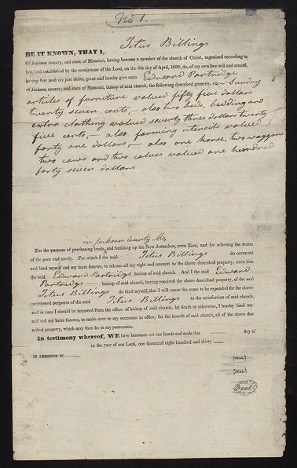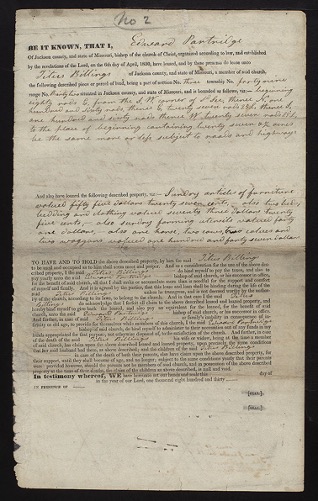Historical Context and Background of D&C 51
Video Overview
Brief Synopsis by Steven C. Harper
What happens when young missionaries convert well over a hundred people in a short time, and then the missionaries and the most mature spiritual leaders among the converts leave town? According to John Whitmer, “The enemy of all righteous [gets] hold of some of those who profesed to be his followers, because they had not sufficent knowledge to detect him in all his devices.”1 According to a local newspaper in northeastern Ohio,
Immediately after Mr. R[igdon] and the four pretended prophets left Kirtland, a scene of the wildest enthusiasm was exhibited, chiefly, however, among the young people; they would fall, as without strength, roll upon the floor, and, so mad were they that even the females were seen in a cold winter day, lying under the bare canopy of heaven, with no couch or pillow but the fleecy snow.2
When one of the missionaries, Parley Pratt, returned from Missouri, he noticed that
some very strange spiritual operations were manifested, which were disgusting, rather than edifying. Some persons would seem to swoon away, and make unseemly gestures, and be drawn or disfigured in their countenances. Others would fall into ecstacies, and be drawn into contortions, cramp, fits, etc. Others would seem to have visions and revelations, which were not edifying, and which were not congenial to the doctrine and spirit of the gospel. In short, a false and lying spirit seemed to be creeping into the Church.”3
John Whitmer reported that after Joseph arrived on the scene “these things grieved the servants of the Lord.” They counseled together at Joseph’s home. They did not know what to do, so Joseph sought and received section 50 “in consequence of their not being perfectly acquainted with the different operations of the Spirits which are abroad in the earth.”4
In section 50 Christ condescends to the elders’ intellectual level in order to be understood. He reaches them where they are and enlightens them. This kind of teaching has results beyond mastery of facts. As a result of it, the weak become strong, the deceived become discerning. Though Satan had power over the deceived elders, those who “attend to the words” of this revelation are promised power over him. “The spirits shall be subject unto you,” Christ assured them on the condition that they act out his instructions precisely. Does it work?
Before the revelation Jared Carter had been confused by and powerless to act in the face of the strange things he witnessed. After the revelation he was neither confused nor powerless. He was conducting a sacrament meeting in Amherst, Ohio with his companion when a young woman fell to the floor. Jared, doubting that the Holy Spirit would interrupt the sacrament, thought a false spirit was at work. He suggested to his companion that they “try that Spirit according to the revelation that God had given.” He explained how they followed verses 31–34 precisely: “We kneeled down and asked our Heavenly Father in the name of Christ, that if that spirit which the sister possessed was of him, he would give it to us. We prayed in faith, but we did not receive the Spirit.”
Jared’s companion made a weak statement “which was not proclaiming against the spirit,” as verse 32 commands. “I arose and proclaimed against it with a loud voice,” Jared wrote, reflecting his intimate knowledge of the revelation. Most of the congregation objected, sure that the young woman was full of the Holy Ghost like the queen in Alma 19. But this was a counterfeit, Jared discerned by the Holy Ghost, and rebuked by the power of the priesthood. He lost much of his influence among that group of Saints but, as he wrote, “I received assurance that I had the approbation of my Heavenly Father, which was better than the good will of many deceived brethren.”5
Section 50 puzzles some modern students, who sometimes jump too hastily to the conclusion that anyone who sees a vision or falls to the floor unconscious or speaks in an unknown tongue is clearly not experiencing the Holy Ghost. If those were the criteria for discerning, we would have to reject large parts of the Book of Mormon and several sections of the Doctrine and Covenants along with much of our history. It is not that simple. Satan is abroad deceiving. As Section 50 says, a knee-jerk reaction against false spirits can actually lead a person to be “seized” with a false spirit themselves. Ironically, a smug certainty that one would not be fool enough to fall for the kinds of things some early converts did may be an indication that one has already been deceived. Joseph taught, “It is that smooth, sophisticated influence of the Devil, by which he deceives the whole world.”6
Discerning spirits takes a sound mind, but it is a spiritual, not primarily an intellectual, process. To gain power over false spirits, one must obey the voice of Jesus Christ, have him cleanse and purify them, and learn the difference between light and darkness. For Joseph Smith, Jared Carter and many others, that lesson has been learned by experiencing both and learning to recognize the difference.
Like Jared Carter, several elders acted out the revelation and got the Church back in order. Parley Pratt told how he obeyed the Lord’s command in verse 37: “Joseph Wakefield and myself visited several branches of the Church, rebuking the wrong spirits which had crept in among them, setting in order things that were wanting.”7
1. “John Whitmer, History, 1831–circa 1847,” p. 10, The Joseph Smith Papers, accessed July 30, 2020.
2. [Matthew S. Clapp], “Mormonism,” Painesville (OH) Telegraph, February 15, 1831, [1]–[2], italics in original.
3. Parley P. Pratt, The Autobiography of Parley Parker Pratt, Edited by Parley P. Pratt Jr. New York: Russell Brothers, 1874), 65.
4. “Revelation, 9 May 1831 [D&C 50],” p. 82, The Joseph Smith Papers, accessed July 30, 2020.
5. Autobiography of Jared Carter, Church History Library, Salt Lake City.
6. Joseph Smith, Journal, 2 January 1843, Church History Library, Salt Lake City.
7. The Autobiography of Parley P. Pratt, revised and enhanced edition, edited by Scot Facer Proctor and Maurine Jensen Proctor (Salt Lake City: Deseret, 2000), 79.


Additional Context by Casey Paul Griffiths
From Doctrine and Covenants Minute
Obedient to the Lord’s commandment to “assemble together at the Ohio” (D&C 37:3), the Knight family and other members of the Colesville Branch departed from their homes in mid-April 1831 to gather with the Saints in Kirtland. Led by Newel Knight, the members of the Colesville Branch were delayed for two weeks in Buffalo, New York, because the harbor was frozen over. After the ice thawed, they weathered the stormy journey over Lake Erie on their way to Kirtland. “Our voyage on [the] lake [was] very disagreeable, nearly all the company being seasick,” Newel Knight later wrote. “However, we arrived in safety at our place of destination” (Rise of the Latter-day Saints, 33).
The arrival of the Colesville Saints and the other Church members from New York proved to be the first test of leadership for Bishop Edward Partridge, who had been called only a few months earlier to look after the temporal needs of the Saints and to implement the law of consecration (D&C 41:9; 42:31–32). At Bishop Partridge’s request, Joseph Smith sought instruction from the Lord and received a revelation providing guidance on how to help the refugees who were arriving from New York.
Orson Pratt was present when this revelation was received. In 1874 he recounted the experience in a discourse given in Brigham City, Utah. An account of Orson’s discourse reads,
Joseph was as calm as the morning sun. But he noticed a change in his countenance that he had never noticed before, when a revelation was given to him. Joseph’s face was exceedingly white, and seemed to shine. The speaker [Orson] had been present many times when he was translating the New Testament, and wondered why he did not use the Urim and Thummim, as in translating the Book of Mormon. While this thought passed through the speaker’s mind, Joseph, as if he read his thoughts, looked up and explained that the Lord gave him the Urim and Thummim when he was inexperienced with the Spirit of inspiration. But now he had advanced so far that he understood the operations of that Spirit, and did not need the assistance of that instrument (Millennial Star, 11 August, 1874, 498–499).
See “Historical Introduction,” Revelation, 20 May 1831 [D&C 51].
